7mm Backcountry – Federal’s New Wonder-Cartridge?
The 7mm Backcountry is Federal’s newest rifle cartridge promising to “reinvent ammunition.”
If you saw my review of their 30 Super Carry, which they called “the greatest advancement in self defense technology,” you already know that I’m critical of Federal’s marketing.
Let’s look at this new rifle load from Federal and see what the 7mm Backcountry round is and how it measures up.
Table of contents
7mm Backcountry Background
7mm Backcountry Specs
- Bullet Diameter 7mm/ 0.284″
- Bullet Weights 155-195 gr
- Muzzle Velocity 3300-3000 fps
- Muzzle Energy 3701-3897 ft/lbs
- Cartridge Length ?”
- Case Length ?”
- Bolt Face 0.470″
- Pressure 80,000 psi
The 7mm Backcountry (7mm BC) is perhaps easiest described as a steel-cased, high pressured, 7mm long-action rifle cartridge.
Federal is introducing this 7mm Backcountry cartridge in 5 loads – it is unclear what other manufactures will adopt this cartridge (my guess is none to very few).
It is initially available in their Terminal Ascent line with 155 and 170 gr options, in a 195 gr Berger Elite Hunter load, in a Barnes LRX 168 gr non-lead option, and in their Fusion Tipped line with a 175 gr bullet.
Bill Geissele, someone for whom I have great respect, chimed in on AR15.com and shared some more information about the new round which he makes a rifle for and seems to really like:
“…The steel case is a special boron alloy. It doesn’t need painted but it is plated…Pressure is around 80,000 psi but can go higher…No primer drop out or pocket enlarging…Bolt thrust is less that a similar brass case because the case wall is not elongating like brass…Case head diameter is 30-06. The round actually looks a little like a 7mm-06…Our King Hunter gun is a mid weight gun and in my estimation recoil is less than a 308 in a light gun…. I have shot other cartridges with this steel case/high pressure technology. This is here to stay”
7mm Backcountry Review – Our Thoughts
It appears that Federal is introducing the 7mm Backcountry round as them “reinventing ammunition.” I hardly think that using a steel case so that they can push higher pressures behind a 7mm bullet is “reinventing ammunition.”
I believe that until someone truly reinvents ammunition, and gets us away from a premiered case, smokeless powder, and a lead/copper projectile, we’re stuck with a few variables to every cartridge. There’s no free lunch here – every cartridge’s performance is effectively a combination of these variables.
We can change the pressure, the case capacity, and the bullet diameter and weight.
Surely, I’m oversimplifying it here, however, that’s effectively all there is to any new cartridge (except for bullet design). Every new cartridge is similar to a cartridge that already exists but the new cartridge has a bigger case for more powder, or a smaller case for more capacity or a smaller action, or a bigger bullet for more energy, or a smaller bullet for more velocity.
I picture a “cartridge creation machine” with a few levers on it: one for pressure, case capacity, length, bullet mass, etc. Moving these levers of my imaginary machine results in different combinations and therefore different cartridges and performance.
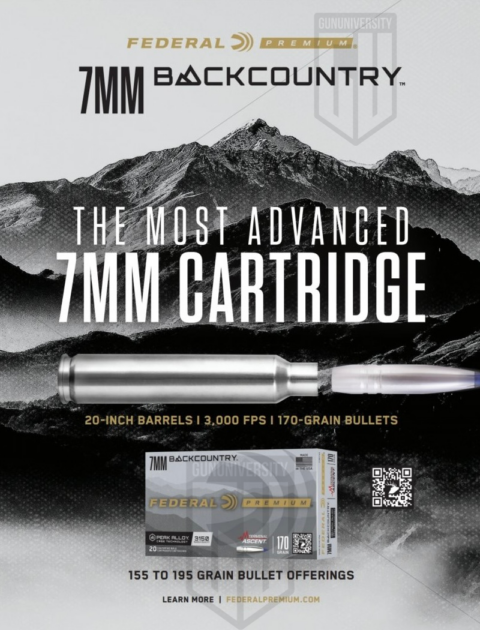
However, there’s no free lunch.
More energy = more recoil.
Lighter and faster bullet = faster velocity and less drop.
Heavier bullet = slower velocity and more drop.
Since Federal has NOT really “reinvented ammunition,” this new cartridge is stuck to the same parameters of other cartridges. What they’ve done is increased the pressure so much to get the velocity they want out of already available 7mm bullets, they needed to use a steel case to contain the pressure.
This is hardly a “reinvention of ammunition.”
It appears that Federal is introducing the 7mm Backcountry as a new cartridge to compete in the fairly new long-range hunting space. If you’ve followed my writing/podcasts, you’ll know that I’m unsettled on “long range hunting.”
On one hand, it is none of my business how you choose to hunt. The fact that you are hunting, if you are, is enough to make me happy as long as you’re being ethical about it.
And there’s the other side – I cringe at many long-range hunters because I don’t think that what they’re doing is ethical to the animal. For example, if you’re shooting far enough away that the bullet is taking a full second to get there (for those that don’t understand long range shooting, a 7mm PRC gets to 750 yards in 1.06 seconds), a LOT can change in that one second (the wind can gust or die-down or the animal could start to move or stop). That change can easily be enough to gut-shot the animal and have it run off and die a painful death and possibly not even be recovered.
Although 200 yards is usually my far-limit to rifle hunting, I’ll admit that I recently took an elk at way farther than I should have. I did it and immediately kicked myself for the risk I took. I got the elk and he died within 10 ft of where he was shot but I can’t throw stones in this glass house.
I imagine Federal wanted a 7mm cartridge to compete with the 7mm PRC and they wanted the bullet to be faster for more energy and less drop at distance and the only way to do that was to use a powder that created such high pressure that a typical brass case couldn’t safely be used so they opted for a stronger steel case.
As far as I’m concerned, using a steel case is going backwards in ammunition evolution, however, they’re claiming that the case is a proprietary alloy. It is unclear whether this alloy is more corrosion resistant, lighter, or stronger.
As far as their claim to it being the “fastest factory 7mm” (in the video above), that might be true with short barrel performance. However, 7mm Remington Ultra Magnum (7mm RUM) can exceed 3,400 fps and is clearly faster than 7mm Backcountry. 7mm RUM is also made by multiple manufacturers, and can do it all without needing a proprietary case.
Mind you, I’m not saying that 7mm RUM is a good idea either – I’m merely addressing the marketing claims of “Reinventing Ammunition” and “Fastest Factory 7mm.”
7mm Backcountry Pros
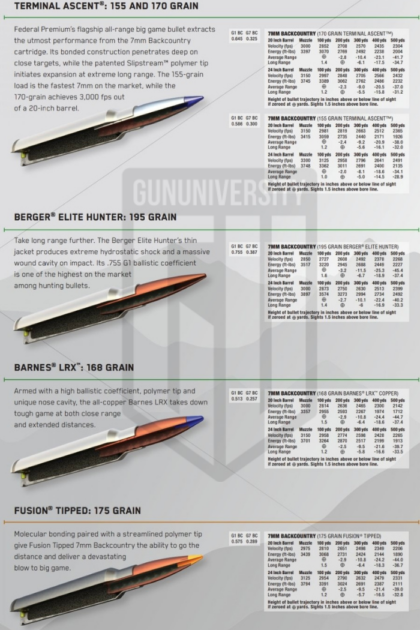
The 7mm Backcountry, on paper and in a ballistics table/chart, blows 7mm PRC out of the water. With the same 170 gr bullet and loaded by the same factory, 7mm Backcountry is getting 200 fps more velocity and 460 ft-lbs more of energy than 7mm PRC.
Additionally, with Federal, we’re getting at least 5 7mm Backcountry load options right out of the gate:
- Federal Terminal Ascent 155 gr
- Federal Terminal Ascent 170 gr
- Berger Elite Hunter 195 gr
- Barnes LRX 168 gr
- Federal Fusion Tipped 175 gr
And, the following rifles are initially being offered in 7mm Backcountry:
| Manufacturer | Model | Barrel Length | Capacity | SKU |
|---|---|---|---|---|
| Savage | 110 Timberline | 20" | 4 | 58323 |
| Savage | 110 Pro Pursuit | 20" | 4 | 58320 |
| Savage | 110 Ultralight Elite | 18" | 3 | 58319 |
| Savage | 110 Trail Hunter Lite | 20" | 4 | 58325 |
| Savage | 110 Ultralight | 20" | 4 | 58321 |
| Savage | 110 Trail Hunter Lite LH | 16.5" | 4 | 58328 |
| Savage | 110 Timberline LH | 20" | 4 | 58324 |
| Savage | 110 Trail Hunter Lite | 16.5" | 4 | 58327 |
| Savage | 110 Trail Hunter Lite LH | 20" | 4 | 58326 |
| Savage | 110 Ultralight LH | 20" | 4 | 58322 |
| Geissele | King Hunter | 20 " | 5 | 08-538 |
| Pure Precision | ? | ? | ? | |
| Christensen Arms | ? | ? | ? | |
| Seekins Precision | ? | ? | ? | |
| Weatherby | ? | ? | ? | |
| Horizon Firearms | ? | ? | ? | |
| Fierce Arms | ? | ? | ? | |
| Allterra Arms | ? | ? | ? | |
| Gunwerks | ? | ? | ? | |
| Proof Research | ? | ? | ? |
If you notice some relatively short barrels in that list, that’s another advertised benefit of the 7mm Backcountry – it is getting high velocities even out of shorter barrels.
Also, with the case diameter being the same as 30-06, it could offer an additional round of capacity in a hunting rifle over larger-cased magnums.
As you can see in the 7mm Backcountry Ballistics section below, Federal is claiming up to 3,150 fps for a 155 gr 7mm bullet out of a 20 inch barrel.
That’s smoking fast.
Simply, if you’re looking for the fastest 7mm rifle out of the shortest barrel, this is clearly it (until the next new round next year).
7mm Backcountry Cons
Like I mentioned above, there’s no free lunch with ballistics.
More energy at the target also means more energy at your shoulder.
Also, pushing the same weight bullet faster will result in more felt recoil.
For a comparison, the 7mm PRC pushes a 170 gr bullet at 2,950 fps. That results in a recoil energy of about 25 ft-lbs out of a 9 pound rifle. Compare that to the 7mm Backcountry pushing the same bullet at 3,150 fps – that results in about 27 ft-lbs of recoil energy.
Is the extra 2 ft-lbs enough to make a difference? For some shooters, yes. This is especially true in lighter weight rifles.
For example, dropping the rifle weight down to 6 pounds has the 7mm Backcountry hitting with an intense 41 ft-lbs of energy (45 ft-lbs with the 195 gr bullet at 3,000 fps).

Another con is the steel case that needs to be used for this cartridge. I’m not sure yet what kind of pressures this cartridge must be running at but I do know one thing: the 7mm Backcountry is not SAAMI approved (yet).
Ammo availability is always something to consider when adopting a new cartridge – especially considering the amount of money and time you’ll dump into getting a new rifle setup for this.
If it needs a special case (it does), then I can’t imagine other manufacturers racing to make 7mm Backcountry ammo. This means it might end up like 30 Super Carry – the shelves are full of it at first because nobody wanted it and then the shelves are empty and it’s difficult to find.
I want a rifle that I can find ammo for at a local store in case I go on a hunting trip and my ammo is forgotten or lost.
With ~80,000psi pressures, this could present problem for someone who takes an older rifle, chambered in 30-06 Sprg, for example, and re-barrels it for 7mm Backcountry – will that older rifle’s bolt and receiver safely be able to handle 80,000 psi? This may be why there isn’t SAAMI approval for this cartridge.
Finally, Federal is saying that these steel cases can be reloaded but I’m suspicious.
7mm Backcountry Pros and Cons
- Fastest 7mm Cartridge (in shorter barrels?)
- High Energy
- Minimal Bullet Drop
- 5 Factory Loads Available
- Higher capacity in rifles than magnums
- Performance in Shorter Barrels
- More Recoil
- Very High Pressures
- Rarer / More Expensive than other 7mm Cartridges
- Not Likely to be Adopted by Many Manufacturers
- Unkown Reloadability
7mm Backcountry vs 7mm PRC
7mm PRC is the most likely comparison for 7mm Backcountry in my mind because it is a new 7mm cartridge pushing the performance of 7mm bullets over older offerings and is aimed at the modern long-range hunting trend.
| Specifications | 7mm Backcountry | 7mm PRC |
|---|---|---|
| Manufacturer | Federal | Federal |
| Product Line | Terminal Ascent | Terminal Ascent |
| Bullet Weight | 170 gr | 170 gr |
| Bullet Diameter | 0.284 in | 0.284 in |
| Bullet Length | 1.621 in | 1.621 in |
| Muzzle Velocity | 3150 fps | 2950 fps |
| Muzzle Energy | 3745 ft-lbs | 3285 ft-lbs |
| 500 Yd Velocity | 2432 fps | 2263 fps |
| 500 Yd Energy | 2232 ft-lbs | 1932 ft-lbs |
| Pressure (psi) | 80,000 psi | 65,000 psi |
| Case Length | ? | 2.280 in |
| Overall Length | ? | 3.340 in |
| Bolt Face | 0.470 in | 0.532 in |
I used two loads for comparison because they used the exact same bullet (170 gr Terminal Ascent) and are loaded by the same manufacturer (Federal). Of course, comparing different weights of bullets will result in different values.
The comparison is straight forward: the 7mm Backcountry pushes the same bullet 200 fps faster out of the muzzle which results in 460 ft-lbs more muzzle energy and it is still going 169 fps faster at 500 yards with 300 ft-lbs more energy.
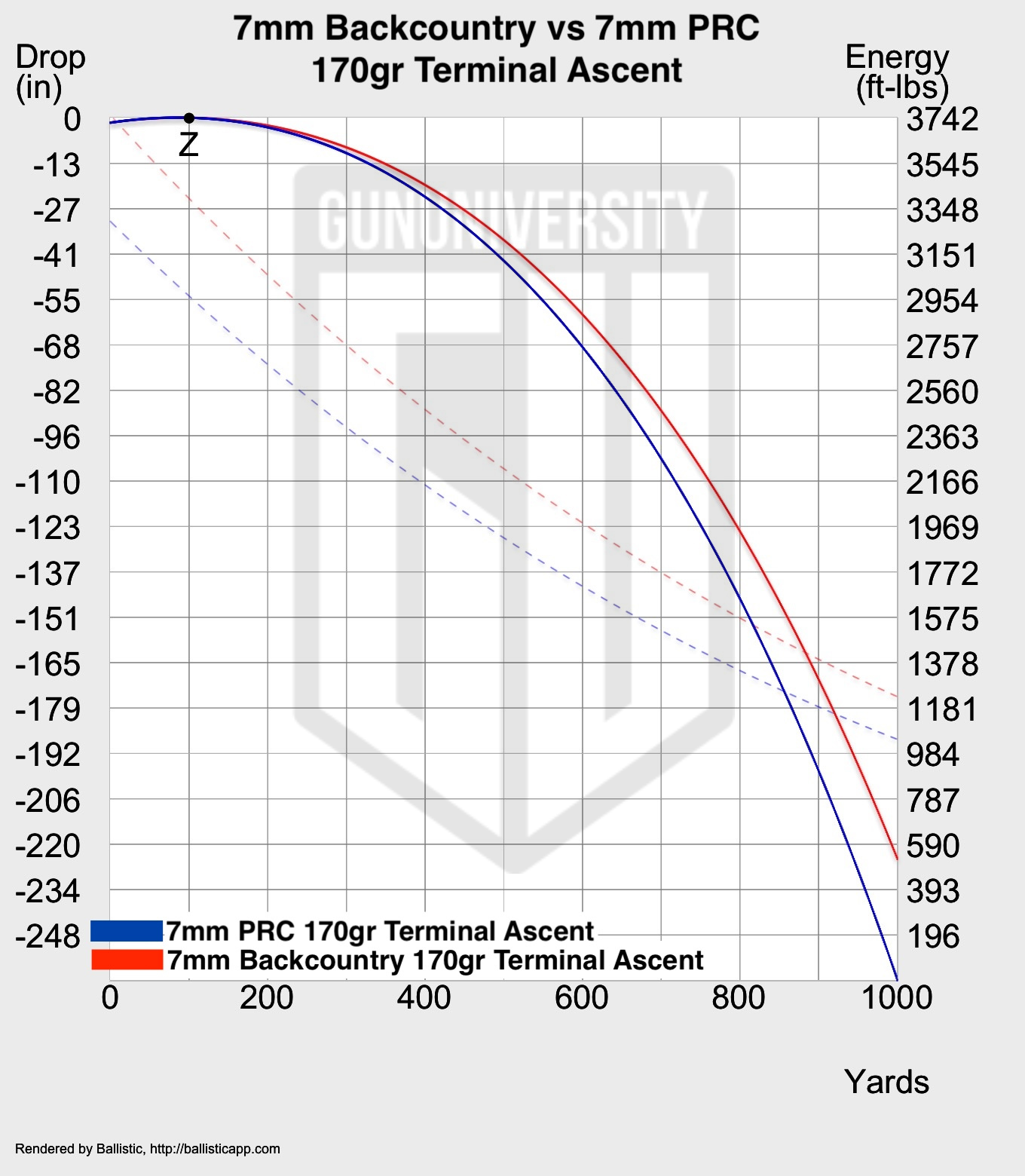
If you want these increased stats and are ok with needing a steel case and possibly investing in an system that uses a difficult-to-find round, then 7mm Backcountry may be for you.
For me, I prefer 300 PRC and compromise down to 7mm PRC for a standard length rifle. I will not be adopting the 7mm Backcountry.
7mm Backcountry Ballistics
For all of you that want the full break-down of all of the statistics about Federal’s 7mm Backcountry, here you go.
We’ve included tables for the velocity, energy, and bullet drop for each of the 5 offerings and have provided the data for both 24 inch and 20 inch rifle barrels.
Enjoy.
7mm Backcountry 20" Barrel Velocity
| Distance (yds) | Terminal Ascent 155 Gr (fps) | Terminal Ascent 170 Gr (fps) | Elite Hunter 195 Gr (fps) | Barnes LRX 168 Gr (fps) | Fusion Tipped 175 Gr (fps) |
|---|---|---|---|---|---|
| 0 | 3150 | 3000 | 2850 | 3000 | 2975 |
| 100 | 2981 | 2852 | 2727 | 2814 | 2810 |
| 200 | 2819 | 2708 | 2608 | 2636 | 2651 |
| 300 | 2663 | 2570 | 2492 | 2465 | 2498 |
| 400 | 2512 | 2435 | 2378 | 2300 | 2349 |
| 500 | 2365 | 2304 | 2268 | 2142 | 2206 |
7mm Backcountry 24" Barrel Velocity
| Distance (yds) | Terminal Ascent 155 Gr (fps) | Terminal Ascent 170 Gr (fps) | Elite Hunter 195 Gr (fps) | Barnes LRX 168 Gr (fps) | Fusion Tipped 175 Gr (fps) |
|---|---|---|---|---|---|
| 0 | 3300 | 3150 | 3000 | 3150 | 3125 |
| 100 | 3125 | 2997 | 2873 | 2958 | 2954 |
| 200 | 2958 | 2848 | 2750 | 2774 | 2790 |
| 300 | 2796 | 2705 | 2630 | 2598 | 2632 |
| 400 | 2641 | 2566 | 2513 | 2428 | 2479 |
| 500 | 2491 | 2432 | 2399 | 2265 | 2331 |
7mm Backcountry 20" Barrel Energy
| Distance (yds) | Terminal Ascent 155 Gr (ft-lbs) | Terminal Ascent 170 Gr (ft-lbs) | Elite Hunter 195 Gr (ft-lbs) | Barnes LRX 168 Gr (ft-lbs) | Fusion Tipped 175 Gr (ft-lbs) |
|---|---|---|---|---|---|
| 0 | 3415 | 3397 | 3517 | 3357 | 3439 |
| 100 | 3059 | 3070 | 3220 | 2955 | 3068 |
| 200 | 2735 | 2769 | 2945 | 2593 | 2731 |
| 300 | 2440 | 2492 | 2688 | 2267 | 2424 |
| 400 | 2171 | 2238 | 2449 | 1974 | 2144 |
| 500 | 1926 | 2004 | 2227 | 1712 | 1890 |
7mm Backcountry 24" Barrel Energy
| Distance (yds) | Terminal Ascent 155 Gr (ft-lbs) | Terminal Ascent 170 Gr (ft-lbs) | Elite Hunter 195 Gr (ft-lbs) | Barnes LRX 168 Gr (ft-lbs) | Fusion Tipped 175 Gr (ft-lbs) |
|---|---|---|---|---|---|
| 0 | 3748 | 3745 | 3897 | 3701 | 3794 |
| 100 | 3362 | 3389 | 3574 | 3264 | 3391 |
| 200 | 3011 | 3062 | 3273 | 2870 | 3024 |
| 300 | 2691 | 2762 | 2994 | 2517 | 2691 |
| 400 | 2400 | 2486 | 2734 | 2199 | 2387 |
| 500 | 2135 | 2232 | 2492 | 1913 | 2111 |
7mm Backcountry 20" Barrel Bullet Drop
| Distance (yds) | Terminal Ascent 155 Gr (inches) | Terminal Ascent 170 Gr (inches) | Elite Hunter 195 Gr (inches) | Barnes LRX 168 Gr (inches) | Fusion Tipped 175 Gr (inches) |
|---|---|---|---|---|---|
| 100 | 0 | 0 | 0 | 0 | 0 |
| 200 | -2.4 | -2.8 | -3.2 | -2.9 | -2.9 |
| 300 | -9.2 | -10.4 | -11.5 | -10.8 | -10.8 |
| 400 | -20.9 | -23.1 | -25.3 | -24.4 | -24.2 |
| 500 | -38 | -41.7 | -45.4 | -44.7 | -44 |
7mm Backcountry 24" Barrel Bullet Drop
| Distance (yds) | Terminal Ascent 155 Gr (inches) | Terminal Ascent 170 Gr (inches) | Elite Hunter 195 Gr (inches) | Barnes LRX 168 Gr (inches) | Fusion Tipped 175 Gr (inches) |
|---|---|---|---|---|---|
| 100 | 0 | 0 | 0 | 0 | 0 |
| 200 | -2.0 | -2.3 | -2.7 | -2.5 | -2.5 |
| 300 | -8.1 | -9.0 | -10.1 | -9.5 | -9.5 |
| 400 | -18.6 | -20.5 | -22.4 | -21.6 | -21.4 |
| 500 | -34.1 | -37.0 | -40.2 | -39.7 | -39 |
EDITOR’S NOTE: Although some people have shared private information with us about this new cartridge, we have not published nor commented on anything that was shared privately. Everything in this article is based 100% on information that was found published online (namely, the three images/brochures about the cartridge, the listing of firearms on retailers’ websites, and other public sources). We are not “leaking” any information – we are merely commenting on what has already been “leaked.”
7mm Backcountry FAQ
Recent Posts
December 15, 2025
December 15, 2025
December 12, 2025
December 12, 2025

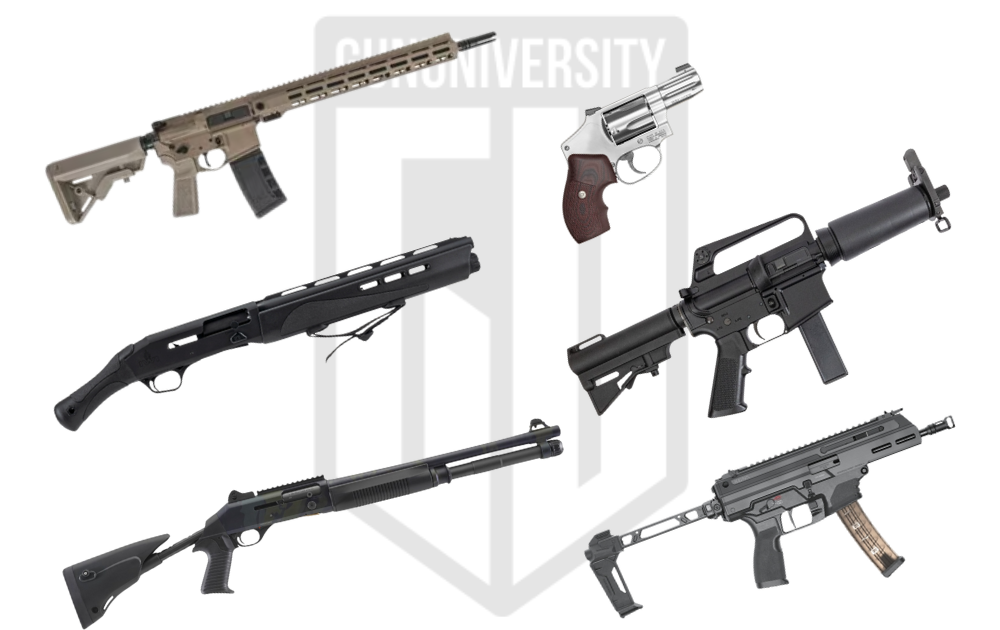
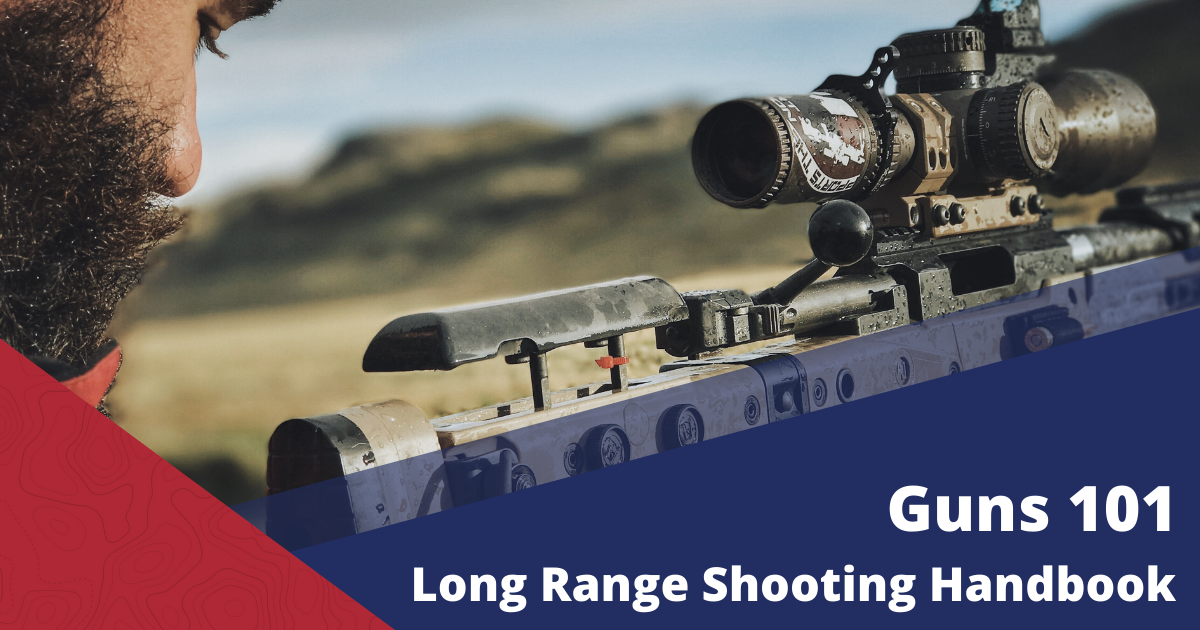
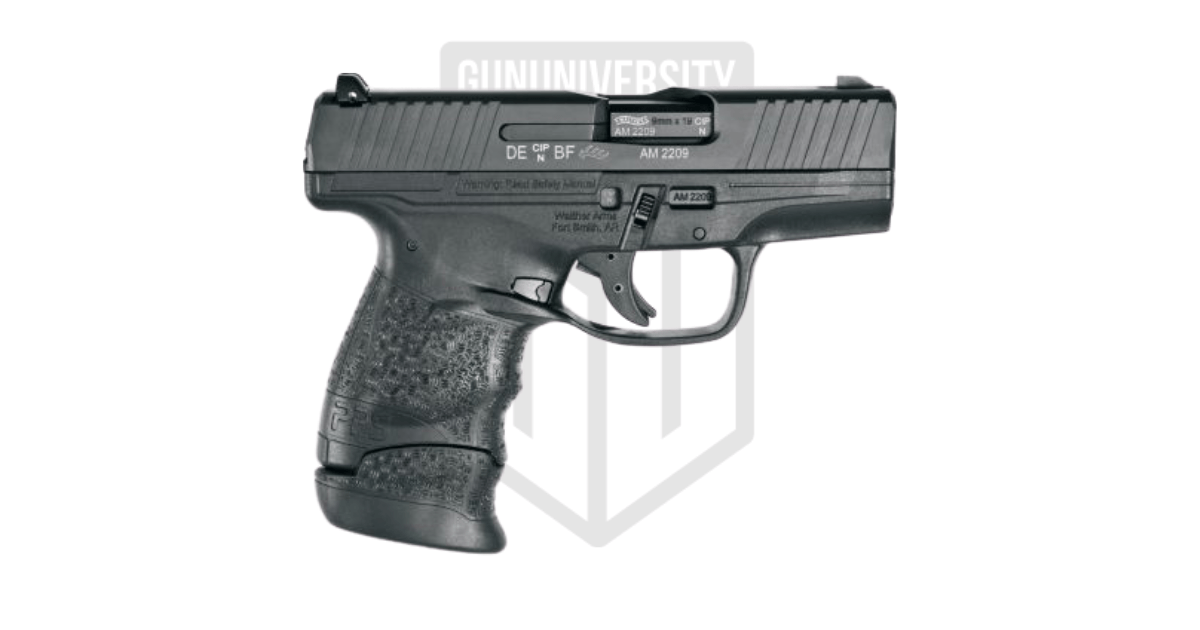
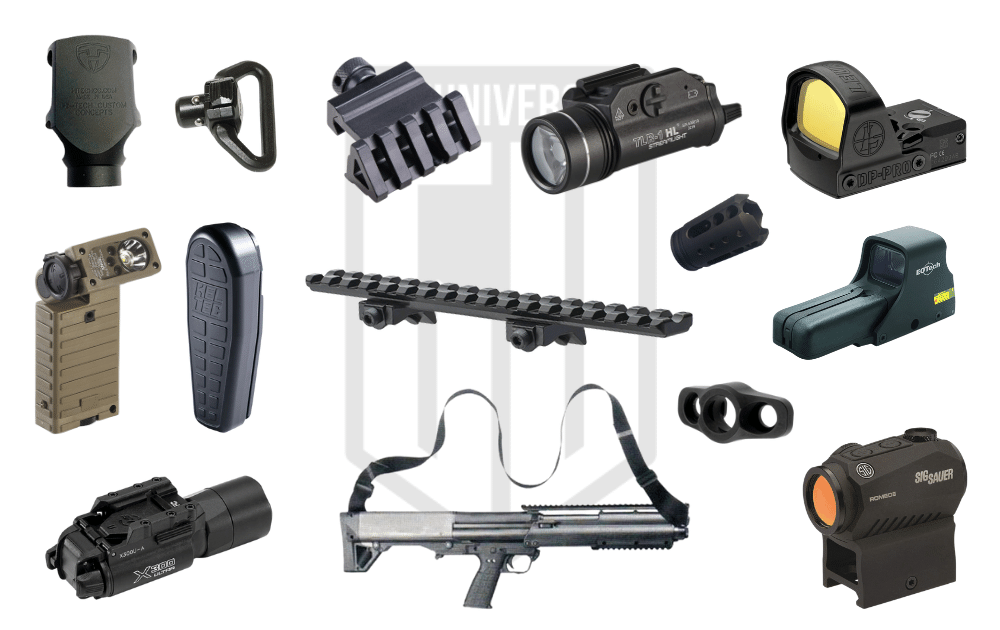
So, its a relatively heavy bullet going fast. Ok,
Super high pressure. Sure to be expensive and a barrel burner.
Hmm,
No thanks. For long range shooting there are better loads that don’t punish the shoulder or kill your bore.
For hunting the limit for range is being able to make a clean ethical shot. That is a shooter skill issue. Seriously there is a video on youtube of a woman shooting a Elk at like 680 yards with a .243 And it dropped like a puppet with the strings cut.
Maybe it’s just me but I am struggling to see a need for this… I think I’ll pass on this one.
Thanks for your common sense statements on long range killing of wild game. I often shoot to 850 and 1200 for fun and friendly competition; however, I limit my shots on game to 500, and then only when conditions are perfect.
I also spend a lot of time at a few public rifle ranges, and I can report that the percentage of rifle hunters out there who have any business shooting game beyond 400 yds is exceedingly small. Like Dirty Harry said years ago, “A good man knows his limitations.”
Thanks, too forctge rest of the article, which is well done and does hit the mark.
a heavier bullet will drop less then a lighter one. it was proved 150 years ago with the 45/70 using 400-500 grain bullets. 500 grain bullets dropped a lot less then the 400 gr. more then what you would think. in a 7mm a 175 or 195 gr match or high BC bullet will drop less then a 155 bullet
Your recoil numbers are wrong. The 7mm BC with less fast burning powder has less projecta coming out of the barrel. You can’t simply calculate bullet weight and velocity to come up with the recoil number. You need to actually measure it
I’m interested but skeptical. The velocities listed and the energy at range is impressive, but accuracy is not in the discussion. Without accuracy the extra velocity only gets you to the wrong place faster. I know that most rifles can be made to be more accurate, with some tinkering, than when they came out of the box. It’s is my opinion, and I could be proven wrong, that some cases are inherently more accurate than others. I’m a fan of the 28 Nosler for this reason and have had great luck with it. I’m sure something better will come along but it’s all just splitting hairs at some level.
Just a suggestion, but perhaps you should actually spend time shooting the cartridge and hunting with it before passing judgement.
Not to be argumentative, but you are using the word “accuracy” when I think you mean “precision”.
Precision is a measure of the mechanical potential of the system.
Accuracy is our ability to place the shots where we want them.
If the case is designed to handle the pressure, I would think any standard length modern commercial action would be fine. Savage didn’t come up with a special 110 for it.
I have no doubt it COULD be reloaded, but I’m betting a technical annealing process is required.
For factory ammunition shooters who are happy with recoil, I don’t see a downside.
I can’t wait for the 375 version to unseat all the 375 Ruger fans.
Probably the more accurate statement would be “any modern action that can safely handle a PRC or WSM cartridge “. The maximum backthrust against the bolt is the chamber pressure multiplied by the max interior diameter of the case. The smaller case diameter vs magnums compensates for the higher pressure.
There is a potential issue with the fast-burning powders that might exaggerate the impact of the back thrust since it will happen faster and be a faster “hammer blow” to the lugs.
Although I have seen claims that the thrust against the bolt is reduced because the case material does not stretch as much as brass, that is ONLY with an absolutely dry chamber that an grip the case. Any residual oil or even a drop of water from rain will effectively serve as a lubricant between the case and chamber. In other words, the rifles need to be strong enough to deal with the full backforce of a lubricated case.
As a good friend has said on more than one occasion related to the gun industry. “It is a solution to a problem that does not exist”.
An additional point, I am a reloader, I will not pursue a cartridge that requires steel cases.